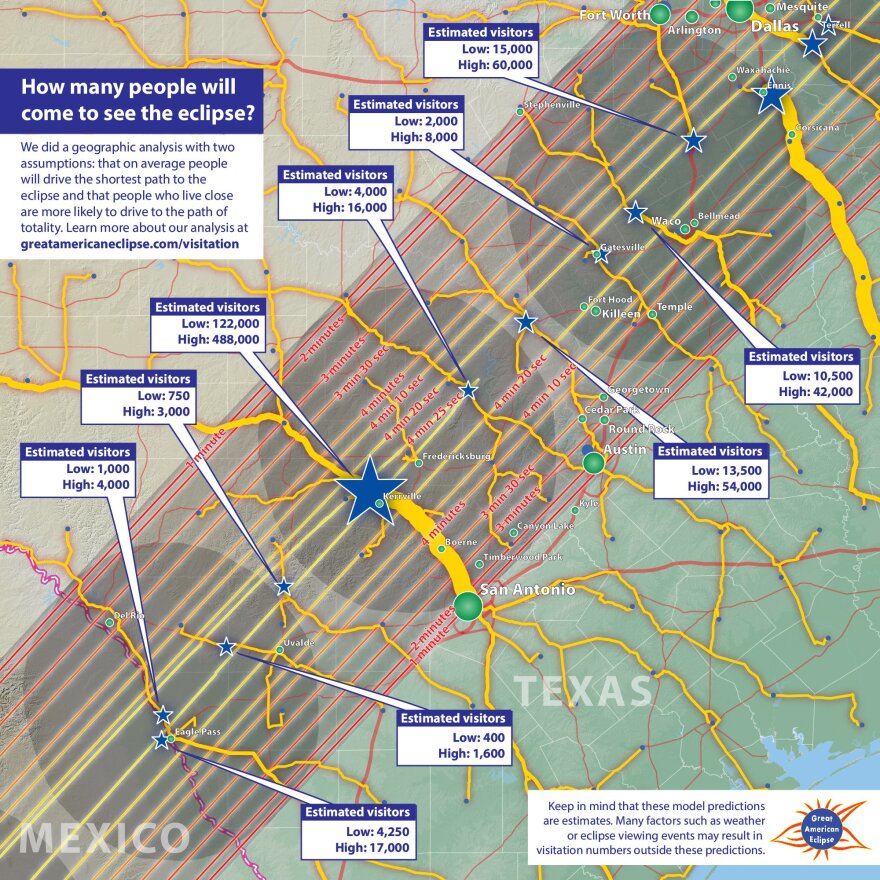Some Central Texas roads could be jampacked with eclipse watchers on April 8, the first time in over a century the moon will completely block the sun in Texas.
Exactly how many people will drive to the path of totality is a shot in the dark. But if the last total solar eclipse in the U.S. is any indication, the gridlock could be historic.
"After the eclipse, everyone got into their car at the same time and there was practically an instant traffic jam on the interstate," eclipse chaser Michael Zeiler recalls of the Aug. 21, 2017, event. His drive down I-25 from Casper, Wyo., to Northern Colorado — normally a three-hour trip — became a grueling 12-hour journey.
A Wyoming Department of Transportation spokesperson told a reporter it was the worst traffic he had ever seen in the state. Part of I-25 had a 403% increase in vehicles after the daylight returned.
This time, the traffic is coming to the Texas Hill Country. The eclipse will center over the scenic, tourist-friendly area that boasts some of the best April weather along the path of totality. Towns like Burnet, Llano and Marble Falls will experience close to the maximum 4 minutes and 28 seconds of daytime darkness.

"That whole area, the Texas Hill Country near the center line can expect massive visitation on eclipse day," said Zeiler, who's planning to watch the eclipse from Fredericksburg, because highways jut out of the city in six directions like bicycle spokes: U.S. 290, U.S. 87 and Texas 16.
"If eclipse morning presents patchy clouds, I've got six ways to relocate," said Zeiler, whose visitation estimates on GreatAmericanEclipse.com are being used by some Central Texas officials to plan for crowds.
His most eye-popping forecast for Central Texas? Up to 488,000 visitors could cram into Kerrville, a town of 25,000 about 100 miles west of Austin. The seat of Kerr County is on I-10, providing a direct pipeline of traffic from San Antonio and Houston.

Kerrville officials doubt they'll get half-a-million visitors but are still bracing for 200,000 or more.
"Every community that we've looked at [after a total eclipse] has experienced not just heavy traffic flow, but an inordinately heavy traffic flow immediately following an event, and we anticipate the same," Kerrville Deputy Police Chief Jerel Haley told council members. "You're just not going to be able to get around as you normally would."
In nearby Fredericksburg, 25 miles closer to Austin than Kerrville, the city of 11,000 is bracing for 100,000 visitors or more.
"I don't really know what to expect. I don't know what it's going to look like to see potentially hundreds of thousands of people here," said Emily Kirchner, a Fredericksburg City Council member who also sits on Gillespie County's eclipse task force. "I'm looking forward to it, although very cautious and concerned."
Back in 2017, interstate highways turned into parking lots. Delays stretched up to 13 hours, according to a Federal Highway Administration (FHWA) webinar with state governments last month. Rural roads were even worse. Some traffic jams were 70 miles long.

The FHWA said 5 million people traveled to see the 2017 eclipse. That's how many the agency is expecting this time, too.
"Rural areas could expect an exponential increase in population during the event," Texas Department of Transportation (TxDOT) spokesperson Brad Wheelis warned in an email.
Eclipse viewers will trickle in over multiple days. But after the sun is blotted out from the sky, an immediate mass exodus could spawn a traffic apocalypse. Some states are asking people not to leave right away, adopting the mantra: "Arrive early. Stay put. Leave late."
TxDOT is following some of FHWA's eclipse advice for traffic. Contractors working on state roads will have to limit construction activity and lane closures.
One notable exception is in Stonewall. That's where U.S. 290 — the main road from Austin to Fredericksburg — will remain narrowed to a single lane in each direction, "which should be exciting for traffic," Fredericksburg Council Member Bobby Watson deadpanned at a December meeting. TxDOT said a bridge project in Stonewall is under construction, so one lane in each direction must remain closed.
The state is now restricting oversized truck loads during the eclipse, according to the Texas Department of Motor Vehicles, which issues permits for supersized cargo. Transportation researchers at South Carolina State University found that restricting oversized trucks was "essential" during the days before and after the 2017 eclipse.
Nebraska was among at least three states to ban oversized loads during the eclipse in 2017.
"We really kind of walked through all the different scenarios on what we thought we might be experiencing that day," Nebraska Department of Transportation Jeni Campana recollected of the decision in 2017. "We were all singing from the same songbook."
TxDOT will have tow truck companies on standby to clear roads in case of a crash or a car breaking down. The state's changeable message signs will flash the following text: "NO STOPPING ON HIGHWAY TO VIEW ECLIPSE, NO PARKING ON SHOULDER, KEEP MOVING."
One of the state's concerns is that last-minute sky-gazers could pull their hot vehicles onto tinder, dry grass and spark a wildfire in areas firetrucks couldn't reach because of traffic.

Hill Country officials have spent months preparing for crowds. Sidewalk barriers are ready. Portable toilets have been reserved. Many local government offices will close April 8 or employees will work remotely.
The eclipse will end around the time school lets out. Some school districts in the path of the totality — including in Marble Falls, Liberty Hill, Burnet, Llano, Fredericksburg and Dripping Springs — canceled classes for the day.
"We don't want kids sitting on buses for hours trying to get through traffic," said Roman Baligad, emergency management coordinator for the City of Dripping Springs.
Austin ISD, Eanes ISD, Pflugerville ISD and Round Rock ISD are keeping schools open during the eclipse to teach about astronomy.
Baligad warned people coming to the Hill Country to fill up their gas tanks or charge their cars and bring extra food and water.
"Fuel supplies may be hindered during the event," Baligad said of the gas stations in less populated areas. "Same thing with electric vehicles. We do not have a lot of charging stations out here in the Hill Country."
Drivers could also head north on I-35. Georgetown, for example, is expected to get more than 3 minutes of the total solar eclipse.

The City of Austin is preparing for the number of visitors it would have over F1 weekend or SXSW.
"Expect delays and long travel times," the city's emergency management director, Ken Snipes, said. "Consider avoiding or rescheduling nonessential travel or telework if possible."
Street lights will turn on automatically, but it's unclear if they'll reach full brightness before the sun is blocked by the moon.
The City of Austin has no street closures planned for the eclipse. But city staff could adjust the timing of traffic signals like they do during major events including SXSW and the Austin City Limits Music Fest.
The Austin Police Department plans to beef up staffing in the days leading up to the eclipse, with officers receiving overtime pay if required, according to a memo from the city's homeland security and emergency management director. Snipes said the 911 call center will have more people working the weekend before the eclipse and through Monday.
The city is hosting watch parties at the Zilker Botanical Gardens, Butler Park and various libraries around town. Only one application has been submitted for a special event permit. That's for a watch party at Waterloo Amphitheater.
Hotels in Austin are filling up fast for early April, according to CBRE, a company that provides data to hotel companies.
"There's definitely going to be an uptick in hotel bookings for that time period," CBRE vice president Kevin Donahue predicted, based on interviews with managers at some of the biggest downtown hotels. "A few managers said they're expecting it to be fully booked for a day or so leading up to it and then probably a day or so after."
Capital Metro is planning to run extra trains to the end of the Red Line for an "Eclipse-nic" at Leander Station, which will get more than 3 minutes and 30 seconds of darkness.
CapMetro's 214 bus to Lago Vista is the farthest west you can go on the public transit network. The 214 comes every 40-60 minutes on weekdays.

The city's network of bike paths offers another way to reach more eclipse time while avoiding major roads. The farther west cyclists go, the more likely they are to encounter "low-comfort" routes with lots of cars and little to no bicycle accommodations.
Austin-Bergstrom International Airport (ABIA) is expecting busy days on April 8 and 9, but city management says the darkened skies won't affect operations. Rental car returns at the airport will be busier than normal after the eclipse, because every available car has been booked, ABIA spokesperson Sam Haynes said.
Some airlines are offering flights to witness the darkening with nothing between you and the horizon. A civilian plane can't keep up with a shadow traveling at 2,000 miles per hour, but the view from 35,000 feet can be breathtaking, as seen in this Alaska Airlines eclipse flight from 2017.
Alaska Airlines told KUT it didn't have any eclipse flights out of Austin.
Delta's Austin to Detroit eclipse flight sold out in 24 hours. The airline offered a second one out of Dallas. Southwest says a regularly scheduled Austin to Indianapolis flight is among eight routes expected to offer a good view of the celestial event.
But a lot of people on the ground in the Austin area will get a good dose of daytime darkness, even if it's not the full 4 minutes and 28 seconds.
"It's like the Super Bowl and the World Series and Christmas and Thanksgiving rolled into one for an astronomer," Zeiler said. "It simply is the most breathtaking sight you will ever see in the sky."








